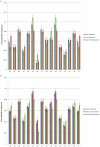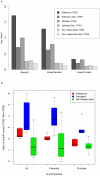Validation of skeletal muscle cis-regulatory module predictions reveals nucleotide composition bias in functional enhancers
- PMID: 22144875
- PMCID: PMC3228787
- DOI: 10.1371/journal.pcbi.1002256
Validation of skeletal muscle cis-regulatory module predictions reveals nucleotide composition bias in functional enhancers
Abstract
We performed a genome-wide scan for muscle-specific cis-regulatory modules (CRMs) using three computational prediction programs. Based on the predictions, 339 candidate CRMs were tested in cell culture with NIH3T3 fibroblasts and C2C12 myoblasts for capacity to direct selective reporter gene expression to differentiated C2C12 myotubes. A subset of 19 CRMs validated as functional in the assay. The rate of predictive success reveals striking limitations of computational regulatory sequence analysis methods for CRM discovery. Motif-based methods performed no better than predictions based only on sequence conservation. Analysis of the properties of the functional sequences relative to inactive sequences identifies nucleotide sequence composition can be an important characteristic to incorporate in future methods for improved predictive specificity. Muscle-related TFBSs predicted within the functional sequences display greater sequence conservation than non-TFBS flanking regions. Comparison with recent MyoD and histone modification ChIP-Seq data supports the validity of the functional regions.
© 2011 Kwon et al.
Conflict of interest statement
The authors have declared that no competing interests exist.
Figures





Similar articles
-
Effects of myogenin on expression of late muscle genes through MyoD-dependent chromatin remodeling ability of myogenin.Mol Cells. 2012 Aug;34(2):133-42. doi: 10.1007/s10059-012-2286-1. Epub 2012 Jul 18. Mol Cells. 2012. PMID: 22814845 Free PMC article.
-
De novo prediction of cis-regulatory elements and modules through integrative analysis of a large number of ChIP datasets.BMC Genomics. 2014 Dec 2;15:1047. doi: 10.1186/1471-2164-15-1047. BMC Genomics. 2014. PMID: 25442502 Free PMC article.
-
Experimental validation of predicted mammalian erythroid cis-regulatory modules.Genome Res. 2006 Dec;16(12):1480-92. doi: 10.1101/gr.5353806. Epub 2006 Oct 12. Genome Res. 2006. PMID: 17038566 Free PMC article.
-
Identifying transcriptional cis-regulatory modules in animal genomes.Wiley Interdiscip Rev Dev Biol. 2015 Mar-Apr;4(2):59-84. doi: 10.1002/wdev.168. Epub 2014 Dec 29. Wiley Interdiscip Rev Dev Biol. 2015. PMID: 25704908 Free PMC article. Review.
-
Deciphering the genome's regulatory code: the many languages of DNA.Bioessays. 2010 May;32(5):381-4. doi: 10.1002/bies.200900197. Bioessays. 2010. PMID: 20394065 Free PMC article. Review.
Cited by
-
Single-nucleus RNA-seq of differentiating human myoblasts reveals the extent of fate heterogeneity.Nucleic Acids Res. 2016 Dec 1;44(21):e158. doi: 10.1093/nar/gkw739. Epub 2016 Aug 26. Nucleic Acids Res. 2016. PMID: 27566152 Free PMC article.
-
A KAP1 phosphorylation switch controls MyoD function during skeletal muscle differentiation.Genes Dev. 2015 Mar 1;29(5):513-25. doi: 10.1101/gad.254532.114. Genes Dev. 2015. PMID: 25737281 Free PMC article.
-
Unveiling combinatorial regulation through the combination of ChIP information and in silico cis-regulatory module detection.Nucleic Acids Res. 2012 Jul;40(12):e90. doi: 10.1093/nar/gks237. Epub 2012 Mar 15. Nucleic Acids Res. 2012. PMID: 22422841 Free PMC article.
References
-
- Arnone MI, Davidson EH. The hardwiring of development: organization and function of genomic regulatory systems. Development. 1997;124:1851–1864. - PubMed
-
- Shimizu S, Miyamoto Y, Hayashi M. Cell-type dependency of two Foxa/HNF3 sites in the regulation of vitronectin promoter activity. Biochim Biophys Acta. 2002;1574:337–344. - PubMed
-
- McBride DJ, Kleinjan DA. Rounding up active cis-elements in the triple C corral: combining conservation, cleavage and conformation capture for the analysis of regulatory gene domains. Brief Funct Genomic Proteomic. 2004;3:267–279. - PubMed
-
- Ling J, Ainol L, Zhang L, Yu X, Pi W, et al. HS2 enhancer function is blocked by a transcriptional terminator inserted between the enhancer and the promoter. J Biol Chem. 2004;279:51704–51713. - PubMed
Publication types
MeSH terms
Substances
Grants and funding
LinkOut - more resources
Full Text Sources

